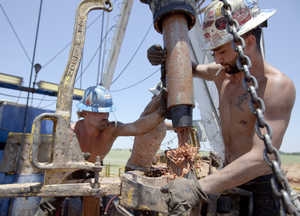It’s over 90 degrees and dusty in the flat terrain just off Country Road 150 in rural Harper County, and early this week the crew from VAL Energy was drilling down 4,800 feet.
Three crews working 24 hours a day with a synthetic diamond rotary bit expected to have the hole drilled in time to take Sunday off.
It’s been 150 years this month since the first commercial oil well was dug in Kansas. The industry in middle age has and hasn’t changed a lot from its wild, greedy, glorious childhood.
It’s true the oil and gas fields are generally well understood now, and producers are introducing new technology, such as 3-D imaging and horizontal drilling. Transportation systems are well established, markets are robust, and the industry is regulated.
But the industry remains driven by the same kind of calculating entrepreneurs who turned Kansas into a major producer of hydrocarbons. They have figured out how to survive with $10-a-barrel oil, tightening government regulation and aging oilfields.
Kansas’ oil and gas industry is still big business very big.
The industry employs an annual average of 13,800 people paid $814 million, an average salary of nearly $60,000 per year, according to a recent University of Kansas study, which was funded by the Kansas Independent Oil and Gas Association.
It makes up between 2.5 and 4.5 percent of the state’s economy, depending on the prices, said study author Art Hall.
The oil and gas industry has become a smaller part of the economy over the past 50 years as the industry has pumped less and the state economy, particularly in Johnson County, has grown.
“It’s shrinking as a fraction of the overall state economy,” Hall said. “But if you go out to where oil and gas is found, it represents a quarter of the jobs in some counties and 60 to 70 percent of the property tax.”
Oil and gas, like aircraft construction, has a powerful ripple effect. Add in the new cars and restaurant food bought by oil workers, and the number of jobs grow to 28,000, payroll to $1.4 billion and state and local taxes to $403 million.
And throw in every Kansas job touched by the oil and gas industry, such as refinery workers, fuel haulers, even the clerk selling gasoline at QuikTrip, and the number of employees swells to 68,000, payroll to $2.7 billion and taxes to $930 million.
But many in the Kansas oil industry feel that the majority of people don’t understand them and their industry. They’ve been too successful, they say, breeding complacency on the part of their customers. That opens the door for more government regulations.
Most Kansans, like most Americans, have no connection with the industry, they say. They don’t see how having an oil and gas industry benefits them, and they fail to see it as similar to other large employer-taxpayers such as Cessna Aircraft or Sprint Nextel.
Dick Schremmer, owner of Bear Petroleum in Haysville, said his own employees sometimes lose sight of the connection, complaining when the price of gasoline goes up at the pump.
“I just shrug my shoulders and go on,” he said. “They don’t understand that it provides them with some pretty good benefits, it provides them with a paycheck that doesn’t bounce…. Wake up and smell the bacon.”
First strike
The territory’s first commercial oil well, in June 1860, was a year older than the state itself and came just a year after the first U.S. commercial well, the Drake No. 1 in Titusville, Pa.
The man responsible for the Kansas well was George W. Brown.
One of the territory’s most controversial journalists, Brown ran a pro-free-state newspaper in Lawrence that was burned during an attack by pro-slavery raiders in 1856.
He had heard about the strike in Titusville and even went to Pennsylvania to study it. He was well aware of the general interest in “rock oil” as a replacement for rapidly dwindling supplies of whale oil and as an alternative to coal oil.
He had heard about tar seeps in Miami County, just south of Johnson County. Brown gathered a group of investors and drilled three not-very-productive wells near Paola.
“The third time he drilled, he actually struck a trace of oil,” said Teresa Bachman, executive director of the Kansas Oil Museum in El Dorado.
“It wasn’t really a producing well, but we consider that the first commercial oil well: the first one in Kansas, the first one west of the Mississippi and the first one in the Mid-Continent Field.”
The Mid-Continent Field was to become the granddaddy of American oil, stretching over Texas, Oklahoma, Kansas, Arkansas, Louisiana and New Mexico.
Boom days
Fort Scott became the state’s first boomtown in 1867, and other towns in southeast Kansas enjoyed some success over the next 40 years.
A strike in Neodesha in 1893 drove enough drilling to attract John D. Rockefeller’s Standard Oil Co. to build a refinery.
But the industry reached a whole new level in 1915, when the Stapleton No. 1 well proved that there were huge supplies of oil and gas under El Dorado.
What followed was one of those spectacular gold-rush-like booms, in which thousands of people left their farms to seek their fortune.
Other wells followed and, in 1916, a refinery was built to handle 20,000 barrels a day. Driven by the world war, demand and prices shot up, accelerating the frenzy of development. Some wells were producing 20,000 barrels a day.
In 1918, Butler County produced 36 million barrels of oil. The county’s population jumped from 23,000 in 1910 to 43,000 in 1920. Photographs of Oil Hill, just west of El Dorado, show the bare prairie thick with wooden rigs.
“It looked like a forest,” Bachman said.
Stores stayed open night and day to serve the overnight crews. Bachman has receipts from one store that was selling $60,000 a month in new clothes to grimy oilfield workers. One industrious laundress, Bachman said, earned $4,000 to $6,000 a month washing the filthy clothes.
Locals even capitalized by renting their own beds, she said.
“They were called ‘hot beds’ because the men would have their 12-hours (shifts) and one man would get up and the next would put his sheets down and climb in.”
Working in the oil patch
By the mid-1920s, the crazy boom in Butler County had eased into a more stable daily routine, although production remained very strong.
Producers moved farther west in the state. Gas was found in Hugoton in 1920; oil was found in Russell County in 1923.
By 1936, it was estimated the value of the oil in Kansas equaled the value of its wheat crop for the first time. Then came World War II and its demand for oil.
Carl Henn was raised on a farm near Leon in the 1920s and ’30s. At 15, he started working in the oilfields during the summer. The decision to leave home and farming life was simple, he said.
“It was something to do and you got paid for it,” he said. “On the farm you didn’t get paid.”
He never really looked back. He spent nearly his entire career in El Dorado, mostly with Cities Service, the biggest oil producer, keeping machines big and small running.
Dale Wilson was a driller his whole life, running his own company, W.W. Drilling, from 1969 to 1997.
Wilson bears a disconcerting dent on the right side of his forehead courtesy of a piece of pipe.
“A quarter-inch to either side and it would have sent me 6 foot under,” he said.
As it was, it he spent several weeks in the hospital.
He ran old-fashioned drilling rigs using cable tools, heavy weights that were lifted and dropped to bore the hole.
He recalls one incident when gas mixed with the oil and the workers didn’t realize it. As they were unbolting a plate on the well, the gas exploded and shot the 2,000 pounds of tools up out of the well; they landed at the workers’ feet.
“If you stay around long enough, you’ll see lots of things happen,” he said, with a wry grin.
Risk-reward business
The industry in Kansas is made up of hundreds of medium-sized and small companies, but none of the fully integrated majors such as ExxonMobile or BP.
One of those is VAL Energy of Wichita, one of the state’s largest oil well drillers.
The company has six rigs going full time. Five are contract rigs, hired simply to drill a hole, and one drills on its own leases. The company has 150 wells that produce about 2,250 barrels of oil and oil equivalent a day.
The industry in Kansas is largely filled with families who have been in the business for generations, said one of the owners, Todd Allam.
Allam got into the business as a kid, learning from his uncle, who operated some oil wells around Burrton.
The appeal, he said, is the risk and the high return for it.
“You got to be almost a manic-depressive to ride the highs and take the lows,” he said with a laugh. “It’s an up-and-down, volatile business not only in the discovering or not discovering, but in the prices.”
He’s taken a good bit of the risk out of the business by running most rigs as a contract service and by drilling for himself mainly in established areas.
For true wildcatters, who rely on the seismology and their gut to find oil or gas, he said, one out of seven turns out dry.
And that can be very expensive. It costs about $200,000 to drill a dry hole and $500,000 for a finished, operating well. Much of the cost of a dry hole can be written off taxes.
In Kansas, the amount of oil recovered has generally been trending down, although it has risen in the past few years as higher oil prices have spurred more exploration.
Kansas isn’t finished as an oil and gas state, Allam said, but it is getting harder to find.
“We have found all of the easy-to-get-to oil,” he said.
The secret is technology, which has made some extraordinary strides in recent years. The introduction of horizontal drilling and advanced fracking techniques have dramatically expanded the amount of natural gas reserves in the U.S. and can help in Kansas, he said.
And newer techniques, such as pumping carbon dioxide and nitrogen into exhausted wells, can bring them back to life.
And, he said, while we won’t find any more gushers, people will be drilling and pumping in Kansas for a while longer.
“Hopefully for decades,” he said, “because I’m bringing my family and my kids into this business.”
Read more: http://www.kansas.com/2010/06/24/1374784/drilling-turns-150.html#ixzz0rmcHmYXZ

